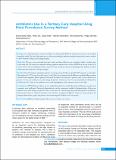Please use this identifier to cite or link to this item:
https://hdl.handle.net/20.500.14356/968| Title: | Antibiotics Use in a Tertiary Care Hospital Using Point Prevalence Survey Method |
| Authors: | Kafle, Kumud Kumar Jha, Nisha Kafle, Sajala Manandhar, Tejendra Bajracharya, Omi Devkota, Pragya Bajracharya, Suraj |
| Citation: | KafleK. K., JhaN., KafleS., ManandharT., BajracharyaO., DevkotaP., & BajracharyaS. (2023). Antibiotics Use in a Tertiary Care Hospital Using Point Prevalence Survey Method. Journal of Nepal Health Research Council, 20(3), 683-688. https://doi.org/10.33314/jnhrc.v20i3.3883 |
| Issue Date: | 2022 |
| Publisher: | Nepal Health Research Council |
| Keywords: | Antibiotics Nepal Point prevalence survey Tertiary care center |
| Series/Report no.: | July-Sep, 2022; |
| Abstract: | Abstract Background: Point prevalence survey on antibiotic use developed by WHO are already in use in acute care hospitals around the world. The aim of this study was to collect prescribing of antibiotics using Point prevalence survey method in KIST Medical College and Teaching Hospital. Methods: This was a cross sectional descriptive study and data collection was completed within 8 working days in the study site. The study was conducted among inpatients admitted at or before 8:00AM on the day of survey in various wards. Patient sampling was done as per the Point Prevalence Survey methodology. Data analysis was done and presented as frequencies and percentages. Results: Out of 32 patients, maximum patients were of age group 20-30 years and 19 (59%) patients were females. Most patients, 8 (32%) were from the surgery ward. There were patients from 8 different wards including a patient who had renal transplant. Blood, sputum, urine and CSF culture were done in 11 patients, only 2 urine cultures were positive. At least one antibiotic was used among 18 patients. Ceftriaxone (34.4%) was maximally used followed by levofloxacin (3%). One or two antibiotics were used in prophylaxis with a duration of one to five days. Conclusions: WHO Point prevalence survey methodology has been used in this study. Ceftriaxone was the most commonly used antibiotics. Parenteral administration was the commonest method of administration. At least one antibiotic was used among 18 patients. There is presence of a functioning Drugs and Therapeutics Committee, Infection Prevention & Control Committee and committee on pharmacovigilance. However, many indicators for hospital infrastructure, policy and practice and monitoring and feedback were not present. Keywords: Antibiotics; Nepal; point prevalence survey; tertiary care center. |
| Description: | Original Article |
| URI: | http://103.69.126.140:8080/handle/20.500.14356/968 |
| ISSN: | Print ISSN: 1727-5482; Online ISSN: 1999-6217 |
| Appears in Collections: | Vol 20 No 3 Issue 56 july-Sep, 2022 |
Files in This Item:
| File | Description | Size | Format | |
|---|---|---|---|---|
| 3883-Manuscript-30776-1-10-20230314.pdf | Full Article. | 211.51 kB | Adobe PDF |  View/Open |
Items in DSpace are protected by copyright, with all rights reserved, unless otherwise indicated.
